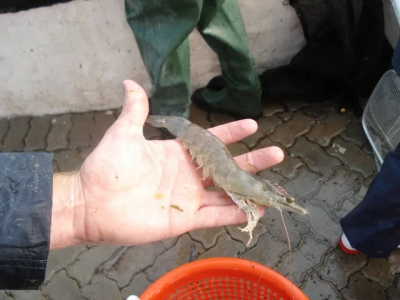How can we save the global shrimp industry from devastating diseases?

Stable, biosecure, zero water-exchange aquaculture is the only remedy for repeated catastrophic loss from disease in the shrimp industry, according to Panama-based shrimp RAS expert Dr Bill McGraw.
The US shrimp industry remains tiny, despite a number of key shrimp research breakthroughs occurring in the country.
Boom and bust can best describe the history of the shrimp aquaculture industry, which is stuck in a rut, firmly resisting change. In my country of residence – Panama – shrimp aquaculture has not changed in 50 years, relying on extensive, low-density systems of five shrimp per square metre. Panama, like most of the world, experienced tremendous losses from the highly contagious white spot syndrome virus during the 1990s and, although borders supposedly remain closed due to the possibility of disease introduction, shrimp production has remained relatively stagnant in a country that has tremendous potential.
The United States remains the leader in the study of shrimp disease – in fact it was the first country to develop genetic lines that are disease free. Specific Pathogen Free (SPF) shrimp produced in hatcheries propelled the United States shrimp aquaculture industry forward during the early 1980s, resulting in an all-time high of 2,700 tonnes at the end of 1994. But the following year would bring the disaster of both white spot and Taura virus, decreasing total aquaculture shrimp production by two thirds. The outbreaks were supposedly due to processing infected shrimp from Asia, which then spread the disease from pond to pond via water exchange.
Production rose again, and by 2003 yielded 5,500 tonnes – an advance attributed to breeding disease resistance into domesticated shrimp grown in open-air ponds. That year’s yield remains the all-time high for the US. Regrettably, it was followed by a steady decline, this time due to the flood of cheap imports – a phenomenon which continues to this day. Zero water-exchange (recirculation) technology remains limited to the research stage in the US due to the high costs of coastal land, feed, labour and electricity, as well as the need to provide heat for the systems for at least five months each year. Current nationwide production is at a low of 1,700 tonnes. Nearly all of this comes from open-air ponds, as attempts to grow shrimp intensively indoors have resulted in consistent failure over the past 25 years.
In Panama, meanwhile, the modern shrimp aquaculture industry began at roughly the same time as in the US (1975-1980), established by the pet food giant Purina. As in the US, Panama suffered devastating outbreaks of white spot during the 1990s, which here resulted in a 90 percent decrease in shrimp aquaculture production. Although the technology for zero water exchange is available in Panama, the tremendous profit potential has yet to be tapped due to lack of investment, nonexistent government support and the absence of a viable avenue to acquire the proper SPF genetics necessary for higher growth rates.
Accurate figures for the current Panama shrimp industry are hard to come by. As fishery statistics are nonexistent, all figures for wild harvest are estimated from export statistics. Therefore, Panama’s shrimp production figure may be more a reflection of what the authorities would like it to be than of the industry’s actual output.
On a worldwide scale, shrimp disease has decimated or grossly affected nearly every shrimp production area. Currently, 52 percent of all shrimp consumed globally comes from aquaculture – therefore, food security is a serious issue when discussing disease in shrimp culture.
Asia, which grows 80 percent of all the shrimp in the world, reported that multiple diseases caused profits to fall by $20 billion during the last decade, and by $10 billion the decade before. Ecuador, the biggest shrimp producer in the Western Hemisphere, saw exports decrease by 70 percent circa 2001 due to white spot virus. The second biggest shrimp producer in South America, Brazil, reported a 30 percent drop in production in 2016, due to white spot. During the same year Australia suffered a white spot disease outbreak too.
Production destruction due to disease is not limited to shrimp aquaculture. For one the most widely grown fish in the world, tilapia, the current status is also gloomy. Tilapia lake virus, which can cause up to 90 percent mortality, has been identified in the major tilapia producing countries of Colombia, Ecuador, Egypt and Israel. The salmon industry also faces various disease challenges, from a range of different vectors.
According to a dissertation by Sylvia Bolanos of Miami University, the survival of the shrimp industry in Panama would require full vertical integration, polyculture with other species and the introduction of a higher priced organic shrimp product for markets in the US. Also, an obvious requirement would be the prevention of another disease outbreak like white spot virus – from which, according to Bolanos, “the Panamanian farms have never truly recuperated”.
Without the employment of biosecure, zero water-exchange technologies, the next viral pandemic is likely to strike Latin America. The question is not if but when. Only a paradigm shift to more sustainable aquaculture practices will prevent this.
Có thể bạn quan tâm
 Aquatic product exports hit 1.64 bln USD in Q1
Aquatic product exports hit 1.64 bln USD in Q1 The export of key aquatic products posted strong rises in many markets in the first quarter of 2021, increasing Vietnam’s aquatic export turnover
 Tuna exports soar
Tuna exports soar Vietnam exported $74 million worth of tuna in April, a 50 percent year-on-year surge, with the U.S. and E.U. buying more.
 Developing Vietnam’s marine aquaculture on industrial scale
Developing Vietnam’s marine aquaculture on industrial scale On May 21, the webinar on developing Vietnam’s marine aquaculture on an industrial scale was launched with the attendance of representatives from Vietnam